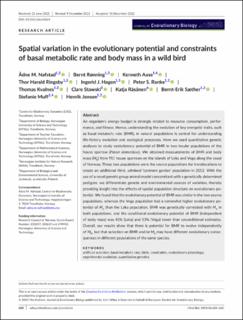| dc.contributor.author | Nafstad, Ådne Messel | |
| dc.contributor.author | Rønning, Bernt | |
| dc.contributor.author | Aase, Kenneth | |
| dc.contributor.author | Ringsby, Thor Harald | |
| dc.contributor.author | Hagen, Ingerid Julie | |
| dc.contributor.author | Ranke, Peter Sjolte | |
| dc.contributor.author | Kvalnes, Thomas | |
| dc.contributor.author | Stawski, Clare | |
| dc.contributor.author | Räsänen, Katja | |
| dc.contributor.author | Sæther, Bernt-Erik | |
| dc.contributor.author | Muff, Stefanie | |
| dc.contributor.author | Jensen, Henrik | |
| dc.coverage.spatial | Leka, Vega, Norway | en_US |
| dc.date.accessioned | 2023-08-21T07:50:32Z | |
| dc.date.available | 2023-08-21T07:50:32Z | |
| dc.date.created | 2023-03-10T13:15:55Z | |
| dc.date.issued | 2023 | |
| dc.identifier.issn | 1010-061X | |
| dc.identifier.uri | https://hdl.handle.net/11250/3084949 | |
| dc.description.abstract | An organism's energy budget is strongly related to resource consumption, performance, and fitness. Hence, understanding the evolution of key energetic traits, such as basal metabolic rate (BMR), in natural populations is central for understanding life-history evolution and ecological processes. Here we used quantitative genetic analyses to study evolutionary potential of BMR in two insular populations of the house sparrow (Passer domesticus). We obtained measurements of BMR and body mass (Mb) from 911 house sparrows on the islands of Leka and Vega along the coast of Norway. These two populations were the source populations for translocations to create an additional third, admixed ‘common garden’ population in 2012. With the use of a novel genetic group animal model concomitant with a genetically determined pedigree, we differentiate genetic and environmental sources of variation, thereby providing insight into the effects of spatial population structure on evolutionary potential. We found that the evolutionary potential of BMR was similar in the two source populations, whereas the Vega population had a somewhat higher evolutionary potential of Mb than the Leka population. BMR was genetically correlated with Mb in both populations, and the conditional evolutionary potential of BMR (independent of body mass) was 41% (Leka) and 53% (Vega) lower than unconditional estimates. Overall, our results show that there is potential for BMR to evolve independently of Mb, but that selection on BMR and/or Mb may have different evolutionary consequences in different populations of the same species. | en_US |
| dc.description.abstract | Spatial variation in the evolutionary potential and constraints of basal metabolic rate and body mass in a wild bird | en_US |
| dc.language.iso | eng | en_US |
| dc.rights | Navngivelse 4.0 Internasjonal | * |
| dc.rights.uri | http://creativecommons.org/licenses/by/4.0/deed.no | * |
| dc.subject | artificial selection, basal metabolic rate | en_US |
| dc.subject | birds | en_US |
| dc.subject | constraints | en_US |
| dc.subject | evolutionary physiology | en_US |
| dc.subject | experimental evolution | en_US |
| dc.subject | quantitative genetics | en_US |
| dc.title | Spatial variation in the evolutionary potential and constraints of basal metabolic rate and body mass in a wild bird | en_US |
| dc.title.alternative | Spatial variation in the evolutionary potential and constraints of basal metabolic rate and body mass in a wild bird | en_US |
| dc.type | Peer reviewed | en_US |
| dc.type | Journal article | en_US |
| dc.description.version | publishedVersion | en_US |
| dc.rights.holder | © 2023 The Authors | en_US |
| dc.subject.nsi | VDP::Matematikk og Naturvitenskap: 400::Zoologiske og botaniske fag: 480 | en_US |
| dc.source.pagenumber | 650-662 | en_US |
| dc.source.volume | 36 | en_US |
| dc.source.journal | Journal of Evolutionary Biology | en_US |
| dc.identifier.doi | 10.1111/jeb.14164 | |
| dc.identifier.cristin | 2133042 | |
| dc.relation.project | Norges forskningsråd: 274930 | en_US |
| dc.relation.project | Norges forskningsråd: 302619 | en_US |
| dc.relation.project | Norges forskningsråd: 223257 | en_US |
| cristin.ispublished | true | |
| cristin.fulltext | original | |
| cristin.qualitycode | 2 | |

